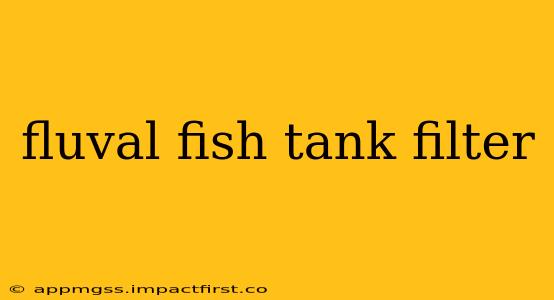Fluval has established itself as a leading brand in the aquarium industry, renowned for its high-quality and innovative fish tank filters. Choosing the right filter is crucial for maintaining a healthy and thriving aquatic environment. This comprehensive guide will explore the various Fluval filter models, their features, and help you select the best one for your aquarium needs. We'll also address some frequently asked questions to ensure you're fully informed before making your purchase.
Understanding Fluval Filter Series
Fluval offers a diverse range of filters catering to different tank sizes and specific needs. Some of their popular series include:
-
Fluval U-Series: Known for its internal design and ease of maintenance, the U-series is a great option for smaller tanks. They're compact, efficient, and perfect for beginners.
-
Fluval C-Series (Canister Filters): This series offers powerful filtration for larger aquariums. Canister filters are known for their superior filtration capacity and quiet operation. They're ideal for experienced aquarists who want optimal water clarity and biological filtration.
-
Fluval G-Series (Internal Filters): Similar to the U-series, the G-series provides internal filtration but often with added features like adjustable flow rates and multi-stage filtration.
-
Fluval Edge Filters: Specifically designed for Fluval Edge aquariums, these filters are integrated into the tank's design, offering a sleek and space-saving filtration solution.
Choosing the Right Fluval Filter for Your Aquarium
Selecting the appropriate filter depends on several factors:
-
Tank size: This is the most critical consideration. Fluval provides clear specifications for each filter model indicating the suitable tank size range. Choosing a filter that's too small will lead to insufficient filtration, while one that's too large might be unnecessarily expensive and disruptive.
-
Type of fish: The stocking level and the waste produced by your fish will influence your filter choice. Larger, more active fish will generate more waste, requiring a more powerful filter.
-
Budget: Fluval offers filters across a range of price points, allowing you to find one that fits your budget without compromising on quality.
-
Maintenance preferences: Consider how much time and effort you're willing to dedicate to filter maintenance. Canister filters require more involved cleaning procedures compared to internal filters.
How Often Should I Clean My Fluval Filter?
The frequency of filter cleaning depends on several factors, including tank size, bioload (number and type of fish and plants), and the type of filter media used. Generally, you should aim to clean your Fluval filter's mechanical components (sponges and filter pads) every 2-4 weeks, rinsing them gently in used aquarium water to avoid disrupting the beneficial bacteria. Avoid using soap or harsh chemicals. Biological media (ceramic rings or bio-balls) should be cleaned less frequently, perhaps every 6-8 weeks or even less often, as these house the beneficial bacteria essential for biological filtration.
What Type of Filter Media Does My Fluval Filter Use?
Fluval filters typically employ a multi-stage filtration system using a combination of mechanical, biological, and chemical filtration media. This includes:
- Mechanical Media: Sponges and filter pads that trap larger debris and suspended particles.
- Biological Media: Ceramic rings, bio-balls, or other porous materials that provide a surface area for beneficial bacteria to colonize and break down harmful waste products like ammonia and nitrite.
- Chemical Media: Activated carbon or other media that can remove unwanted chemicals or discoloration from the water. This is often optional and used as needed.
Can I Use Fluval Filter Media in Other Brands of Filters?
While Fluval filter media is designed to work optimally with their filters, some media, particularly the mechanical and chemical types, might be compatible with other brands. However, always check the specifications of both the media and the filter before attempting to use them interchangeably. The dimensions and the way the media is housed may differ. It's best to stick with Fluval media for the best results and to avoid any potential problems.
What are the Common Problems with Fluval Filters?
Like any mechanical device, Fluval filters can experience occasional issues. These may include:
- Reduced water flow: This could be due to clogged filter media, a malfunctioning impeller, or air trapped in the system.
- Loud noises: This could indicate a problem with the impeller or other moving parts.
- Leaks: Check all connections and seals for any damage or wear.
Most minor problems can be resolved by following the troubleshooting steps in the filter's manual or by contacting Fluval's customer support.
This comprehensive guide provides a solid foundation for understanding Fluval fish tank filters. By carefully considering your tank's specific requirements and following the maintenance instructions, you can ensure your Fluval filter contributes to a healthy and thriving aquatic environment for years to come. Remember to always consult the specific manual for your chosen Fluval filter model for detailed instructions and troubleshooting advice.
